Energy Resources: Fossil Fuels
Fossil Fuels were Indeed Created from Fossils
- Fossil fuels burn today were formed from the tissues of organisms (plants and animals) that lived 100-500 million years ago
- Fossil fuels are produced only when organic materials (carbon) are broken down in an anaerobic environment
- Conditions typically need to include:
- Lots of organic matter (e.g., bottom of lakes, swamps, seas, and coastal oceans)
- High sedimentation rates (bury organic matter fast into anoxic sediments)
- Anoxic sediments (because oxygen will degrade; anoxic will preserve)
Fossil Fuel Formation
- Over time (geologic timescales), compaction of the sediments generates kerogen, a complex organic molecule
- Kerogen eventually breaks down further into simpler hydrocarbons, such as coal, petroleum/oil, or natural gas
- Fossil carbon stores energy that we release when we burn it fossil fuels
Fossil Fuel:
- Coal is a solid
- Oil is a liquid
- Methane is a natural gas so vapor
- Kerogen (rock looking thing)
- Progression of fossil fuel formation occurs with temperature, mostly between 50 and 100
- Cracking = breaking up heavier hydrocarbons into lighter ones
- Heavy vs. light refers to molecular weight as well as density, specific gravity, and viscosity
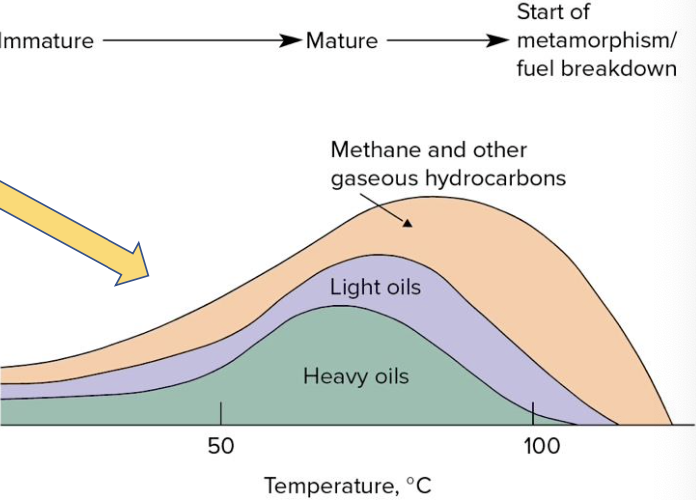
Larger organic molecules (‘heavy hydrocarbons’) will be broken down into smaller molecules (‘lighter hydrocarbons’)
Fossil Fuel Migration
- Once it is liquid or gas, the oil and natural gas can migrate out of the rocks they formed within
- And migrate through other permeable layers of rocks
- Most oil and all gas are less dense than the water found in pores of permeable rocks
- So the gas and oil will move laterally and rise until it (a) hits an impermeable layer or (b) reaches the surface
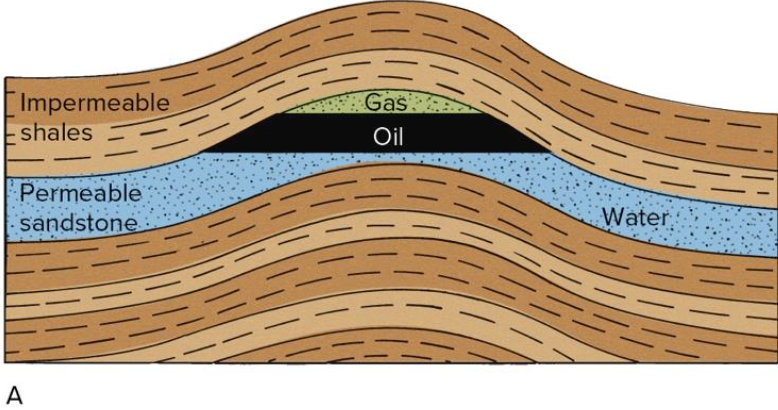
- So the gas and oil will move laterally and rise until it (a) hits an impermeable layer or (b) reaches the surface
Natural Oil and Methane Seeps
- Santa Barbara County, California, USA
Petroleum Traps
Fine-grained clastic sedimentary rocks with low permeability (e.g., sandstone) are most common reservoir rocks.
Accumulating rock (reservoir) must be porous enough to hold a lot of oil or gas and relatively permeable to allow it to flow when drilled. But fracturing with explosives, water or gas also works.
Multiple types of traps exist to keep the petroleum in the reservoir rock.

Very confused about these traps...
Nonrenewable Energy Source
- Timescales of formation not entirely known
- But no petroleum exists in rocks younger than ~2 million years
- Essentially, nonrenewable and we are using it at incredible rates
Supply and Demand
Supply and demand: Oil
- Barrel of oil = 42 gallons = 159 liters
- Consumed globally ⇒ 1 trillion barrels
- Reserves globally = 1.65 trillion barrels
- Half the consumption since ~1995
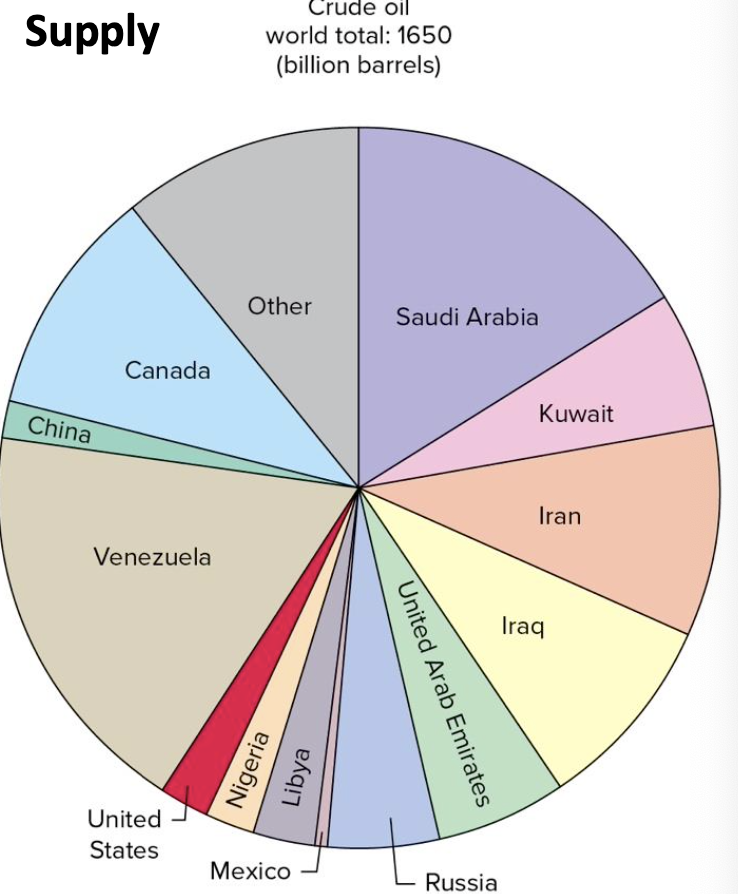
-
Uneven distribution
- Some countries have more than they need (e.g., Libya)
- Some countries do not have enough or any at all (e.g., Japan)
-
Domestic USA oil
- 400 billion barrels produced and consumed
- 33 billion barrels of proven reserves remaining
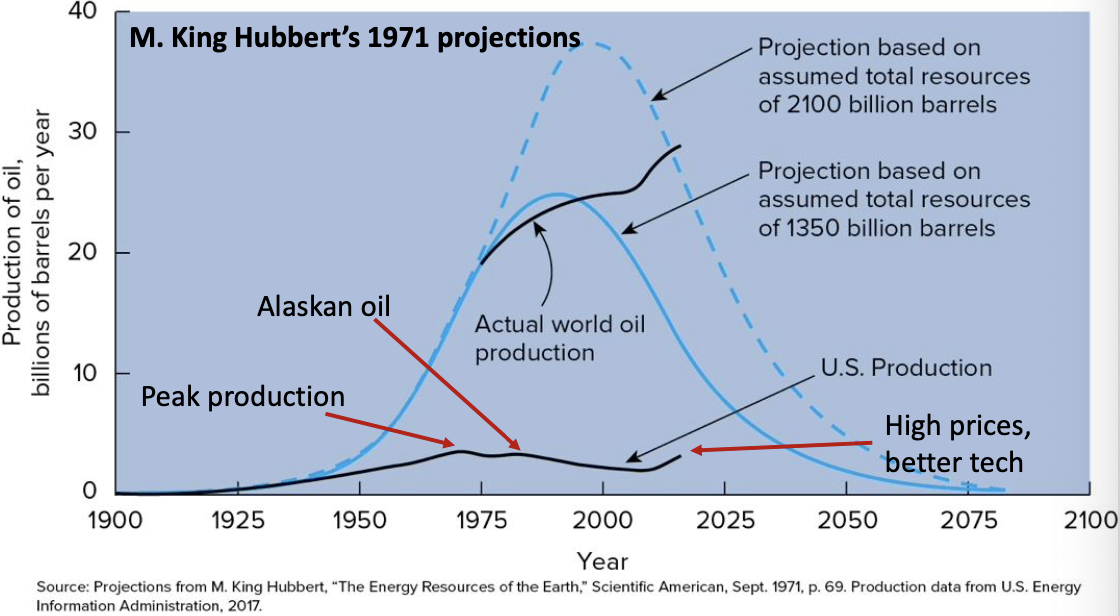
- Hubbert predicted oil production would fall after 1975 due to reserve depletion.
- Obviously it did not!
- Increase in production because of higher prices and improved technology
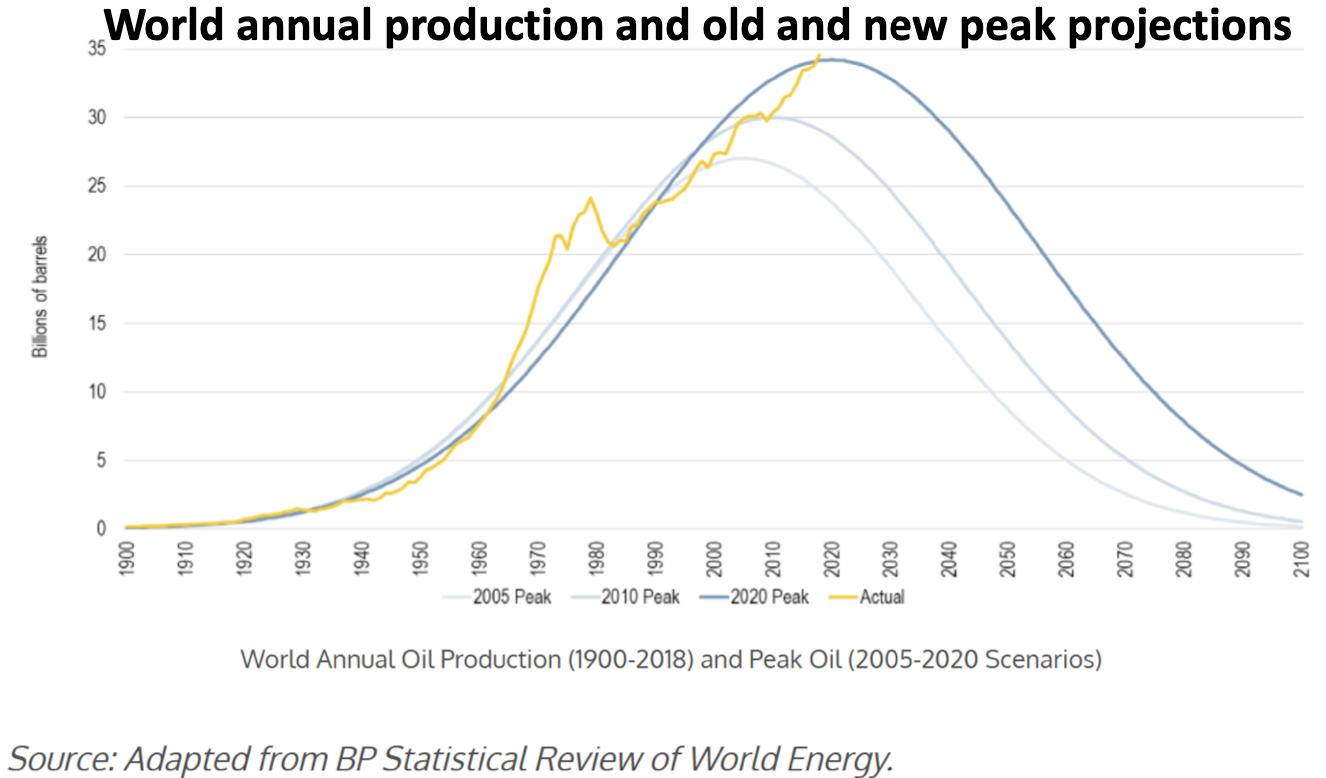
- Current price for barrel oil = 106 CAD
- Barrel of oil = 159 liters
- Divide: 0.66 / liter
- Gas pump prices ~$1.50 / liter
Supply and demand: Oil/Tar Sand
Athabasca Oil Sands (Alberta Tar Sands)
- Athabasca deposit is > 46,000
- Surface mineable is ~2,800
-
170 billion barrels of reserves (~70% of worldwide oil sand reserves)
- 10x more likely in total resources
- Wasteful process:
- 2 tons of oil sand and 4-6 barrels of water ⇒ 1 barrel of oil
- 4x more water wasted and 3x more CO2 emitted compared to conventional oil
- 2.5 million barrels/day produced
- Canada now largest US supplier of oil because of tar sand!
Not to be confused with Oil Shale
- Misnomer: Does not need to be shale and the hydrocarbon is not oil
- Made up of Kerogen - a waxy solid, complex organic molecule formed from remains of plants, algae and bacteria
- The rock must be crushed and heated to distill out of the ‘shale oil’
- USA has ~75% of world’s oil shale
- 70% of that in the Green River formation of Colorado, Utah and Wyoming
- But USA is not using it because
- Too much rock waste
- Not economic compared to petroleum
- Requires strip mining but it’s a desert - little water for mining or reclamation
- In situ mining not yet possible
Supply and demand: Natural gas
- Natural Gas is the Fastest-Growing Fossil Fuel in use today
- Consists of primarily of methane, , and varying amounts of other volatile hydrocarbons
- Can be liquid at high pressures and temperatures in subsurface reservoirs
- Provides 25% of global commercial energy consumption
- World supplies are projected to last about 60 more years
New technology has enhanced domestic supplies of natural gas in USA
- Coal-bed methane: methane associated with coal no longer a dangerous hazard or leaking; Now it is economical to capture and use it
- ~15 trillion ft3 of reserves identified
- Problem: disposal of coal-bed water
- Shale gas: methane in organic-rich shale with low permeability was not economical to extract; Now hydraulic fracturing (fracking) and horizontal drilling allow access to that gas
- Fluid used fracture shale and increase permeability, and sand used to keep the fractures open (largest consumer of sand resources)
- In 2010, 175 trillion ft3 of reserves; In 2020, 473 trillion of reserves
- Problems: ground- and surface water pollution and earthquakes
Known Shale Gas Reserves: Not all of these require fracking, but many do
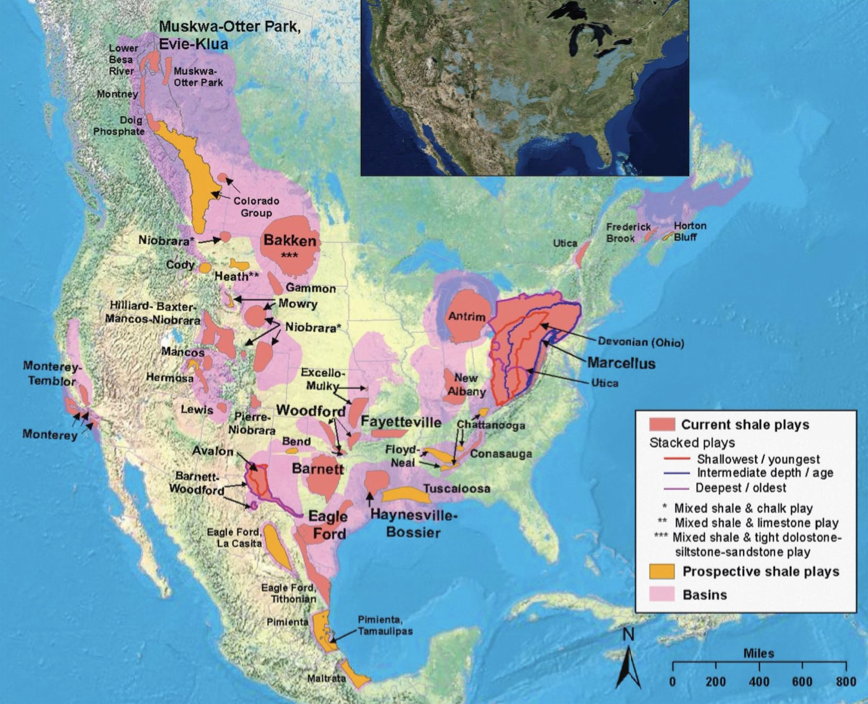
Future Oil and Gas
- Finding new substantial reservoirs unlikely
- Found most of the sedimentary reserves
- Igneous and metamorphic formations not likely to hold oil/gas
- Require high heat to form that rock, which would destroy carbon
- Not very porous or permeable
- Costs of exploration much too high
- Need to drill exploration wells following other types of surveying
- Costs depend on location – remote areas much more expensive
- Wells are far deeper now (6100 ft vs 3600 ft in 1949)
Enhanced Oil Recovery
- Primary + Secondary recovery recovers only ~1/3
- Enhanced (Tertiary) recovery may recover ~40% more
- But could cause ground subsidence or groundwater pollution issues
Unconventional natural gas sources:
- Methane hydrate: crystalline solids of gas and water, typically in an ice lattice
- Forms when methane (natural gas) is at low temperature and moderate pressure
- Japan (2013) and China (2017) have extracted it so far
- Highly Unstable! Disturbing the temperature or pressure may cause explosion (Deepwater Horizon)
- Geopressurized zones: natural gas dissolved in pore water thousands of meters below ground
- Reserves ~150 to 2000 trillion
- Problems:
- Difficult and expensive to drill deep
- Wastewater pollution
- Not likely to develop the technology for recovering this for quite some time
Conservation:
- Unlikely to conserve, especially as developing nations need more energy
- Prices need to incentivize conservation
Oil Spills
-
Large spills are the only ones that make the news, but are volumetrically insignificant compared to the small ones
- Mostly due to carelessness
- Estimate: 10,000 leaks/spills in US waters annually ⇒ 15 - 25 million gallons of oil annually ( up to 600k barrels)
-
Natural disasters also cause more spills
- E.g., Hurricane Katrina (2005) caused 100-500 spills totalling 8 million gallons
-
The large, sudden and catastrophic spills usually due to accidents on offshore platforms/wells or tankers at sea
-
Oil floats on surface
-
Light volatile hydrocarbons evaporate first
-
Sunlight and bacteria decompose more
-
~15% of volume reduced over several months
-
Remaining heavier hydrocarbons make spill more viscous and difficult to remove
Ways to remove?
- Oil booms
- Oil boom and skimmer
- Dispersants
- Manually do it? Remove?
Types of spills:
- Tanker spills
- Amoco Cadiz (France, 1978) spilled 1.6 million barrels, recovered 140,000
- Exxon Valdez (Alaska, USA, 1989) spilled 277,000 barrels
- Most effective beach clean up solution: spray with fertilizer to grow microbes to consume the remaining oil
- Prestige (Spain, 2002) was purposely sunk further offshore but continued to leak and pollute coasts
- Drilling accidents
- Deepwater Horizon (Louisiana, USA, April 2010) hit a methane hydrate pocket while drilling an exploratory well 40 miles offshore
- Leak was at the seabed – methane and oil gushing from the well they could not cap for 3 months!
- 4.9 million barrels (200 million gallons) spilled
- Burned it, skimmed it, dispersed it
- Late 2010 ⇒ 25% remained, 25% burned/collected, 25% dispersed, 25% evaporated/dissolved
The Deep Horizon blowout initiated a lot of necessary oil spill research. Most incredible new finding:
- ‘within a week of surfacing, half of the floating oil was transformed by sunlight into new compounds with different physical and chemical properties’
- Biodegradation does not work as fast as originally thought
Coal Formation
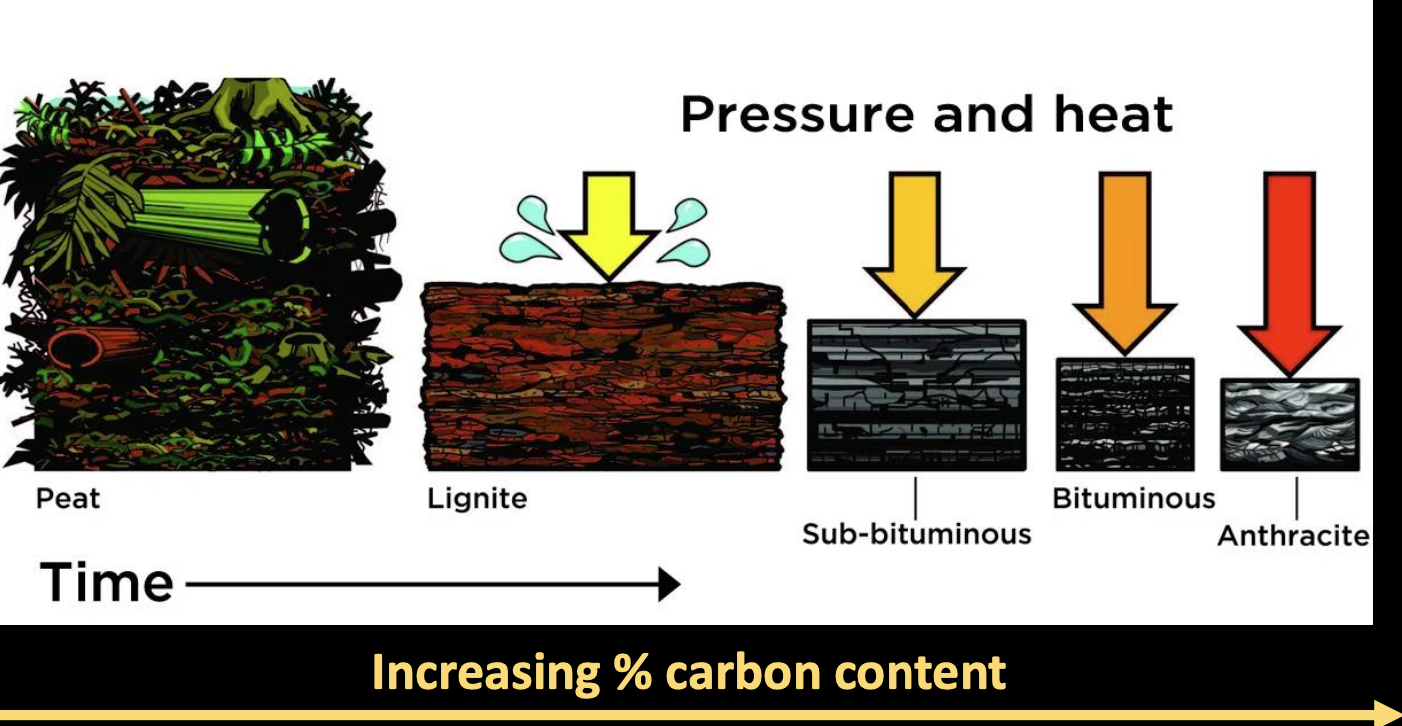
Coal Reserves and Resources
- 15% of total USA energy needs, but half of electric power generation!
- Coal reserves equal >10 x the energy remaining in oil and gas reserves combined!
- Much easier to locate and estimate reserves • >1 trillion tons in reserve
• >10 trillion tons of total resources - USA has 27% of world’s coal
• 4 trillion tons
• Only a few percent used up!
• Remaining reserves could power USA for 200 years - But coal has its limitations…
Coal Limitations
- Cannot be used in modern vehicles
- Dirty and inconvenient
- Gasification: coal converted to a gas mixture (CO, H, some CH4) after reacting with hydrogen gas
- Not used since 1950s
- Heat return is ~15-30% that from natural gas
- Not economical to transport, only used where produced
- Liquefaction: coal converted to gasoline after reacting with steam
- Used in some countries and tech has improved so ~70% of the original coal can be used
- Coal-to-liquids technology push in USA to use vast reserves to replace foreign oil
- But it’s water intensive (6-10 barrels water to 1 barrel of coal liquid), requires more mining, and releases twice as much greenhouse gas emissions
Environmental Impacts of Coal
Gases
- Releases more CO2 than oil or gas because coal has higher C:H ratio
- Releases SO2 (e.g., acid rain) because coal contains >3% sulfur
- Can remove some while refining or trap in exhaust stacks but
$$$$$ - Need low sulfur coal but in the USA it is usually lower grade
Ash
- 5-20% of original volume of coal left as ash that contains toxic metals (selenium and uranium) and must be disposed of
- 1 plant could produce >1 million tons of solid waste a year
- If left on surface, erosion will occur, potentially causing pollution of local waters and sediments
- But its mostly left in landfills
- Sometimes in containment ponds
Coal Mining Hazards
- Underground mining is dangerous: collapse, black lung disease, explosions from natural gas pockets, higher rates of cancer from radon exposure
- Underground fires that can burn for decades
- Centralia, Pennsylvania (USA) has been burning since 1962
- 1000 residents relocated = $40 million
- 38 more such places in Pennsylvania, USA alone
- China’s uncontrolled coal-mine fires consumes 20% of their production and may account for a few percent of global emissions
- India has fires still burning 50 years later too
- Centralia, Pennsylvania (USA) has been burning since 1962
- Strip mining used more now: cheaper despite land reclamation costs
- Sulfuric acid runoff still a problem – stunting land plant growth, contaminating groundwater and surface water, poisoning aquatic life, leaching soil toxins
- Reclaiming land difficult
- Artificial slopes that can cause slides or slumps
- Drainage patterns changed in dry areas
- Runoff an issue in wet areas
- Mountaintop removal surface mining
- Popular in eastern USA (Appalachian Mountains)
- Not easy to restore destroyed mountains
